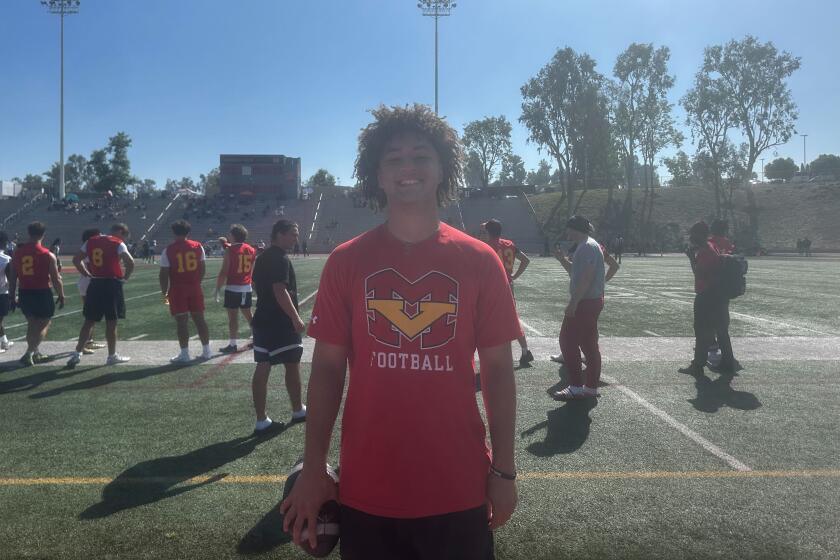Diving boards now rarities at high schools
- Share via
Nancy Ramirez can’t help it.
She cringes every time she watches her daughter, Mission Viejo Trabuco Hills senior Heather Ramirez, do an inward or backward dive off a one- or three-meter springboard.
“From the perspective of where you’re sitting, it looks really close, like they’re going to hit the board,” she said while watching the Southern Section Division I diving championships earlier this month.
The danger hit close to home three years ago when Heather Ramirez struck her head on a one-meter board while attempting a reverse 1 1/2 -pike dive during practice with her club team and fell, stunned and disoriented, into the pool before she was pulled out by lifeguards.
“I don’t remember swimming to the top or getting helped onto the deck, or anything,” Ramirez said. “I just remember all this water and blood just fell down my head. It felt like a dream.”
It looked like a mother’s worst nightmare ... or a school administrator’s.
Wary of such scenes, and fearing worse, California school districts have increasingly taken out, shut down or simply not put in diving boards at on-campus pools because of, primarily, liability issues.
“That’s a district decision, just for safety issues,” said Vince Brown, athletic director at Santa Ana Foothill, where a one-meter springboard was taken out, but a three-meter board still looms, the ladder boarded up and roped off. “I would say liability drives the school, and drives the school district. Unless you really look at those issues, you could really bankrupt a school district.”
Diving is considered an “attractive nuisance,” a draw for anyone looking for fun but also an activity perhaps prone to accidental injury, according to Kevin Toohey, president of Mission Viejo-based Myers-Stevens & Toohey Co. Inc., which provides accident and health insurance to school districts throughout the Western U.S.
“A lot of people are fairly litigious, and school districts are sometimes thought of as having deep pockets,” Toohey said. “They have to be careful.”
Diving faces scrutiny from insurance carriers regarding safety concerns that are similar to those involving pole vaulting and gymnastics. All three sports are feared for their aerial aspects.
“It’s all about injuries, and when an individual has an injury in diving, they don’t just stub their toe,” said Tom Danley, athletic director for the Anaheim Unified School District. “They could end up paralyzed.”
Diving coaches would ask that schools and insurers be prudent, but not paranoid.
“You know, I just don’t buy it,” said Shane Butler, diving coach at Los Alamitos. “Some schools pull out the liability card, but in the 16 or 17 years, I’ve been coaching, I’ve seen maybe three accidents.”
Glenn Short, who coached 2006 City Section champions Danny Gruen and Jamie Flynn, both of Woodland Hills El Camino Real, points to rules meant to safeguard divers as they progress through the ranks.
If a diver fails two dives in a meet, he or she is disqualified. A referee may also disallow a dive he deems too difficult.
“There is some risk, but it’s very manageable,” Short said. “Usually the injuries are scarier than they are serious because the boards are flexible. It looks a lot more frightening than it really is.”
A turn away from on-campus diving boards started in the late 1980s, when the National Federation of High Schools changed its water-depth measurement recommendations for use of a one-meter board from a minimum of at least 10 feet to a preferred -- but not required -- 12 feet.
The revision was for pools built after January 1987, but state high school associations took up the change as a precaution, making some pools and their diving apparatus obsolete.
“No one’s going to re-do their pool to make it legal,” said Irvine Beckman girls’ swimming Coach T.J. Prendergast, who works at a 3-year-old school with a pool that never had diving boards. “It’s a great sport. They do phenomenal things up there, but as far as high schools, it’s a dead duck.”
Of 13 high schools in the Los Angeles City Section that have on-campus aquatic facilities, only five have diving boards. Such situations have left divers to train on their own or with off-campus teams or coaches.
Even competitive meets for high school divers who don’t participate in league events are few and far between. Mission Viejo stages one of a handful of diving invitationals each year.
If there was ever doubt that the Diablos were going to win the Southern Section Division I team title in boys’ swimming this year, it disappeared when their divers claimed the top four spots in the diving portion of the meet a few days earlier.
Diving points are included in team totals at the season-ending swim finals, and by the time the Diablos were done, they had collected 336 points -- and their 25th section championship.
“We’ve won Southern Section titles sometimes thanks to our diving,” Mission Viejo Coach Jeff Boss said. “We’re always going to try to take advantage of it as much as we can.”
Most other schools don’t even have that option.
*
More to Read
Get our high school sports newsletter
Prep Rally is devoted to the SoCal high school sports experience, bringing you scores, stories and a behind-the-scenes look at what makes prep sports so popular.
You may occasionally receive promotional content from the Los Angeles Times.






